Trees Birds Mammals Fish Amphibians Reptiles
Wild Algarve
Bookshop
Desarmillaria tabescens (Scop.) R. A. Koch & Aime - Ringless Honey Fungus
Phylum: Basidiomycota - Class: Agaricomycetes - Order: Agaricales - Family: Physalacriaceae
Distribution - Taxonomic History - Etymology - Identification - Toxicity - Reference Sources
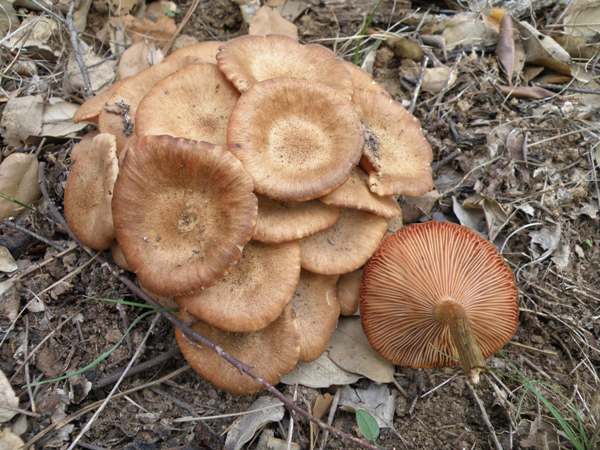
There are many forms of Honey Fungus or Honey Mushrooms as some call them, and in the past they all shared the scientific name Armillaria mellea. Nowadays it is generally accepted that there are several distinct species, one of which, Desarmillaria tabescens, does not have a stem ring. Desarmillaria tabescens is on average a little smaller and usually darker than Armillaria mellea.
Like Armillaria mellea, this parasitic fungus occurs on broad-leaf trees, and oaks in particular.
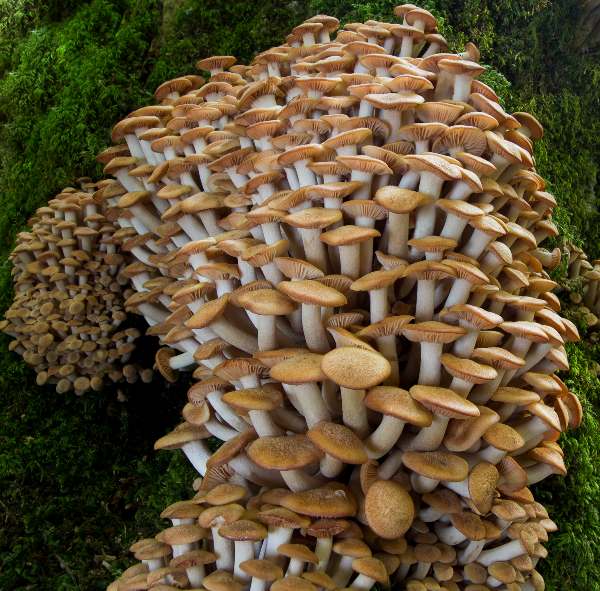
Distribution
Uncommon and rather localised in the south of Britain and Ireland, the Ringless Honey Fungus occurs widely throughout central and southern mainland Europe but is a rare find or not known to occur in some northern countries. This species is also recorded from parts of North America, where it is commonly referred to as the Ringless Honey Mushroom.
Taxonomic history
This species was described in 1772 by Joannes Antonius Scopoli (1723 - 1788), who named it Agaricus tabescens. (In those days most gilled fungi were initially placed in a giant Agaricus genus, now redistributed to many other genera.) Ringless Honey Fungus was moved into its present genus in 2017 by American mycologists Rachel Kochh and M Catherine Aime.
Synonyms of Desarmillaria tabescens include Armillaria tabescens (Scop.) Emel, Agaricus tabescens Scop., Lentinus caespitosus Berk., Pleurotus caespitosus (Berk.) Sacc., Clitocybe tabescens (Scop.) Bres., Armillaria mellea var. tabescens (Scop.) Rea & Ramsb., and Armillariella tabescens (Scop.) Singer.
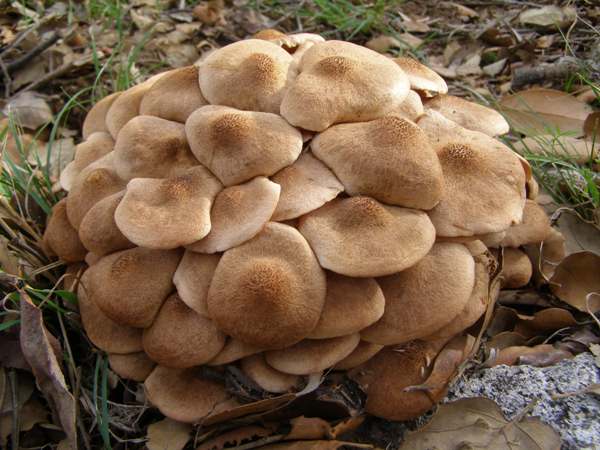
Above: Ringless Honey Fungus on oak roots
Etymology
The specific epithet tabescens means 'wasting away' - probably a reference to the behaviour of this warm-climate species.
Toxicity
Although all honey fungus species were for many years generally considered edible when thoroughly cooked, members of the honey fungus group (including Armillaria mellea, the type species of this genus) that occur on hardwoods are considered by some to be suspect, as cases of poisoning have been linked to eating these fungi; this is most probably due to a small but significant proportion of people being adversely affected rather than a universal human reaction to these fungi. We therefore recommend that this species is not collected for the pot.
Identification guide
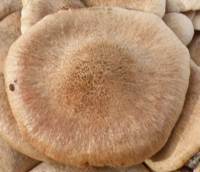 |
Cap
4 to 8cm in diameter; colour ranging from
ochre-brown to red-brown, usually with a darker area towards the centre. The cap
flesh is white and firm.
Initially deeply convex with inrolled margins, the caps flatten and often become centrally depressed with slightly wavy,
striated margins. Fine dark scales cover the young caps, often creating a zoned effect, most noticeably
towards the centre. |
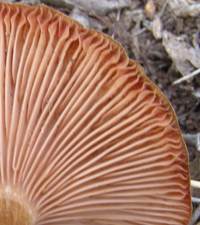 |
Gills
The adnate or weakly decurrent gills are crowded and initially pale
flesh coloured, gradually becoming pinkish-brown at maturity.
Stem
When young, the stems are white, turning yellow or yellowish-brown and
finely woolly as the fruitbody matures.
5 to 14mm in diameter and 5 to 14cm tall; tapering at base where several stems are fused together (caespitose). The
stem flesh is whitish and there is no ring. |
| |
Spores
Ellipsoidal, smooth, 8-10 x 5-7µm; amyloid.
Spore print
White or very pale cream. |
Odour/taste |
Astringent odour and bitter taste. |
Habitat & Ecological role |
Parasitic and/or saprobic on the roots and occasionally the lower trunk area of broad-leaf trees, most commonly oak trees (including evergreen as well as deciduous oaks). |
Season |
June to November in Britain and Ireland; several weeks later in southern Europe. |
Similar species |
Armillaria mellea, commonly referred to as Honey Fungus, is larger and paler but otherwise quite similar; however, it has a stem ring.
Armillaria gallica has a bulbous stem and a fleeting cobweb-like ring that becomes merely a yellowish ring zone at maturity.
Pholiota
squarrosa is generally similar in colour and covered in scales;
it retains an in-rolled margin, the gills turn uniformly rusty-brown,
and it has a radish-like smell and taste. |
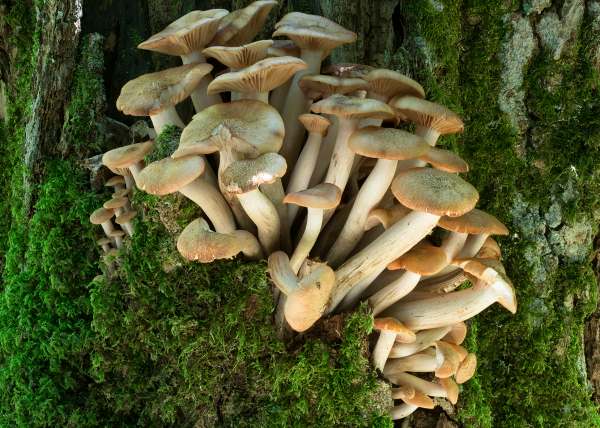
Reference Sources
Fascinated by Fungi, 2nd Edition, Pat O'Reilly 2016, reprinted by Coch-y-bonddu Books in 2022.
Koch R. A et al (2017) Resolved phylogeny and biogeography of the root pathogen Armillaria and its gasteroid relative Guyanagaster. BMC Evol. Biol. 17, 33 (2017) htpps://rdcu.be/cfOI9
Pegler DN. (2000). 'Taxonomy, nomenclature and description of Armillaria'. In Fox RTV. Armillaria Root Rot: Biology and Control of Honey Fungus. Intercept Ltd. pp. 81–93. ISBN 1-898298-64-5.
Funga Nordica: 2nd edition 2012. Edited by Knudsen, H. & Vesterholt, J. ISBN 9788798396130
British Mycological Society, English Names for Fungi.
Dictionary of the Fungi; Paul M. Kirk, Paul F. Cannon, David W. Minter and J. A. Stalpers; CABI, 2008
Taxonomic history and synonym information on these pages is drawn from many sources but in particular from the British Mycological Society's GB Checklist of Fungi.
Acknowledgements
This page includes pictures kindly contributed by David Kelly.
Top of page...
Fascinated by Fungi. Back by popular demand, Pat O'Reilly's best-selling 450-page hardback book is available now. The latest second edition was republished with a sparkling new cover design in September 2022 by Coch-y-Bonddu Books. Full details and copies are available from the publisher's online bookshop...